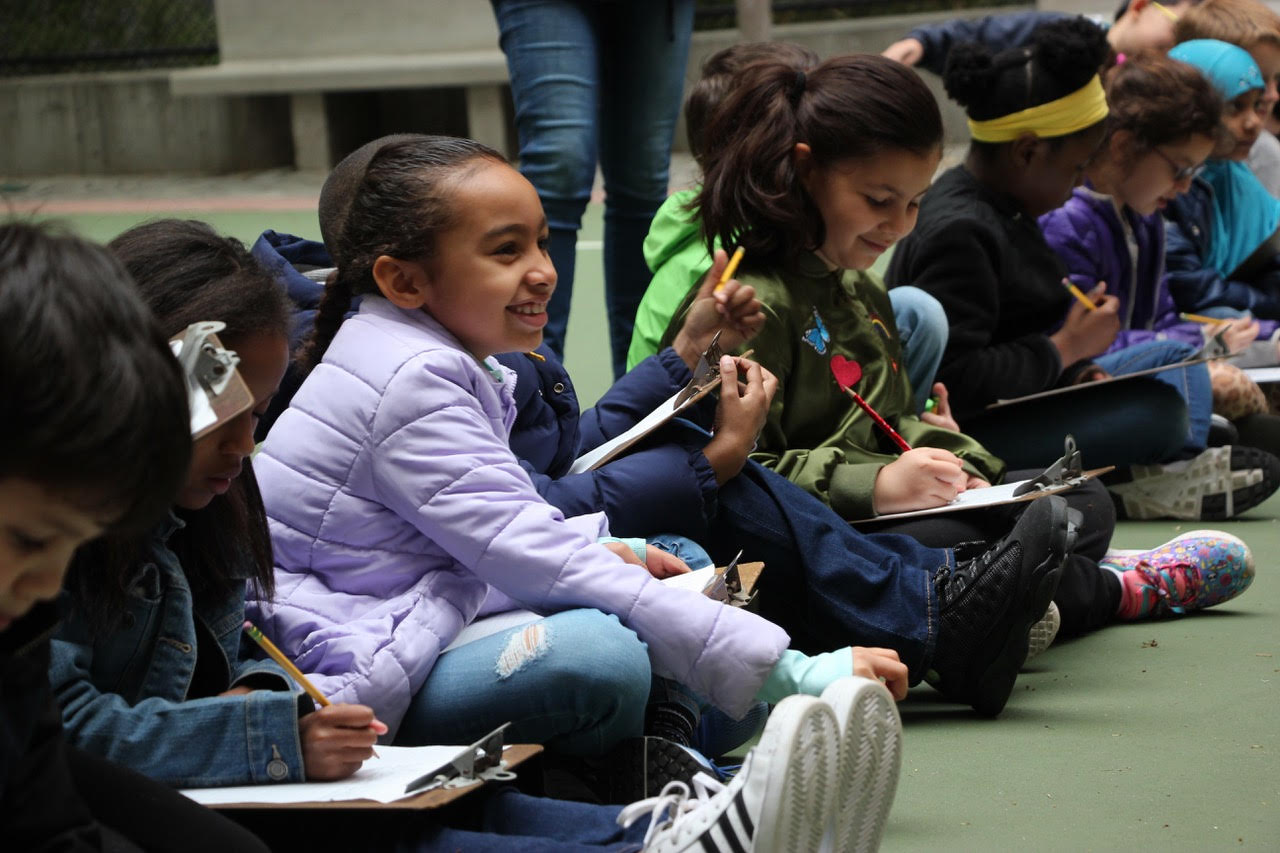This lesson is part of Writing Our Way Through: clear, fun, and engaging “lessons” for writing at home with young people.
Author/Teaching Artist: Matthew Burgess
Age Range: All ages
Materials: Papers and pencils/pens
Overview
In this lesson, we will be writing poems about the soul. I’ve been teaching a version of this lesson in elementary schools for almost twenty years, and it’s one of my all-time favorites. Let me preface by assuring you that you don’t need any formal knowledge or expertise about A. poetry or B. the soul. Phew. All you need is an open mind and enough pencils and sheets of paper for everyone participating. Also keep mind that you don’t have to follow these steps strictly. Read them through before beginning the activity and then follow your instincts about what might work best given your circumstances.
The Steps
1. Read one or both of the poems aloud: “Some Questions You May Ask” by Mary Oliver and “A Noiseless Patient Spider” by Walt Whitman. Just read them aloud in a natural voice and allow them to hang in the air for a few moments. Don’t feel compelled to explain the poems’ significance or analyze them in any way. The poems will create a mood, a feeling, an atmosphere. This is enough. The main thing is to allow participants to share any thoughts or observations about the poem(s) without giving the impression that we’re supposed to “solve the riddle.”
If you feel at this point it would be helpful or interesting to talk about metaphor, the literary device often used in these poems, you can explain that a metaphor is when we compare two things that are different but share some intriguing similarity, such as “The moon is a soccer ball kicked into the sky by my big brother.” A simile is almost the same thing, but you include “like” or “as” to make the comparison: “The moon is like a soccer ball…” In the Mary Oliver poem, there’s a simile in the first line: “Is the soul solid, like iron?” Of course, if you’d rather delay the naming of literary devices for now, you can always revisit this later after the poems have been written.
2. Write the word “SOUL” on a blank sheet of paper, or if you have one, a white board. Ask the participants the following: What do you think the soul is? Where do you think the soul is located? What might the soul do? What is its purpose? Just be sure to phrase your questions in a way that allows for many possible interpretations. Since there is no single “right answer” here, the point is to enter into the mystery together and generate a list of possibilities. As participants share ideas, jot them down. This can lead to very interesting conversations.
Note: if it takes a few moments before anyone has something to say, don’t be afraid of the silence. In my experience, everyone has ideas about what the soul might be, but they sometimes need a moment to dwell in the mystery before raising their hand.
3. Once you have some ideas on the page, set them aside and give the following prompt: Since no one knows for certain what the soul is, let’s compare the soul to other things to see if we might capture some of its qualities or its essence. Simply make a list beginning with phrases such as: “My soul is…” “My soul is like…”, or “My soul dreams about…”

As usual, you can remind participants that descriptive (“delicious”) details make their writing more exciting. For example, “My soul is a dog” is less vivid than “My soul is a Shiba Inu lightly sprinkled in snowflakes after a cold morning stroll.” It can be helpful to ask for volunteers to share some potential lines aloud, so that everyone can hear examples before writing begins. Another option is to read one or more of the student model poems below.
4. Set a timer for a mutually agreed upon amount of time with the understanding that everyone tries to write for the duration. I recommended 5-7 minutes, with an exception: if everyone is still in the flow when the alarm is about to sound, you can press pause to delay the interruption.
5. Once the timer sounds (or you sense that participants are reaching a natural conclusion), invite everyone to silently read what they wrote. Just read through what you wrote and see what came up. Then invite volunteers to share aloud.
6. These soul poems look great on a fridge, wall, or bulletin board. We’d love to read them, too. You can find us on Instagram (@twc_org), Twitter (@twc_org), Facebook (Teachers & Writers Collaborative). Wherever you share online, include the hashtags #twc, #writing our way through, or #wowt.
Literary Terms, Forms, and Devices: Metaphor, simile, repetition, “list poems”
Acknowledgments / References: See also: “My Soul Is…” Poems in Poetry Everywhere, edited by Jack Collom and Sheryl Noethe, and Peter Markus’s “Love Is a Big Blue Cadillac”: Using Metaphor To Explore Concrete and Abstract Nouns” in Spellbound: The Art of Teaching Poetry.
Mentor Texts
Some Questions You Might Ask
Is the soul solid, like iron?
Or is it tender and breakable, like
the wings of a moth in the beak of the owl?
Who has it, and who doesn’t?
I keep looking around me.
The face of the moose is as sad
as the face of Jesus.
The swan opens her white wings slowly.
In the fall, the black bear carries leaves into the darkness.
One question leads to another.
Does it have a shape? Like an iceberg?
Like the eye of a hummingbird?
Does it have one lung, like the snake and the scallop?
Why should I have it, and not the anteater
Who loves her children?
Why should I have it, and not the camel?
Come to think of it, what about the maple trees?
What about the blue iris?
What about all the little stones, sitting alone in the moonlight?
What about roses, and lemons, and their shining leaves?
What about the grass?–Mary Oliver
A Noiseless Patient Spider
A noiseless patient spider
I mark’d where on a little promontory it stood isolated,
Mark’d how to explore the vacant vast surrounding,
It launch’d forth filament, filament, filament, out of itself,
Ever unreeling them, ever tirelessly speeding them.
And you O my soul where you stand,
Surrounded, detached, in measureless oceans of space,
Ceaselessly musing, venturing, throwing, seeking the spheres to connect them,
Till the bridge you will need be form’d, till the ductile anchor hold,
Till the gossamer thread you fling catch somewhere, O my soul.–Walt Whitman
Student Poems
My Soul
My soul is a hunter surviving through the world.
My soul is like the sea sparkling in the sun.
My soul is like a lion scaring my doom.
My soul is an angel that calms my anger.
My soul is an inventor that invents my smartness.
My soul is a tiger running in air.
My soul is a fighter that fights my sadness.–Michael C., Grade 2
My Soul
My soul is a mystery love ticket:
Mom, Dad, Grandma, Grandpa
and the big giant goldfish.
My soul is falling out of the window
and never dies.
I know my soul, I know
my soul.
My soul is an elevator
that leads to your
love, so I know my soul.
My soul is my whole family!–Gao Z., Grade 2
My Soul
My soul is like a big fast cheetah
running around in the forest.
running around in the forest.
It’s like I have a butterfly inside my body.
When I’m happy, my soul feels like a king
that has a golden crown
with a black, white, and purple cap.
It’s like there’s a big world
inside me that I should believe in myself,
and tells me to be me.–Jordan F., Grade 2
My Soul
My soul is Michelangelo
making a big sculpture
out of one piece of marble.–Isaac K., Grade 2
Matthew Burgess is an Associate Professor at Brooklyn College. He is the author of eight children's books, most recently The Red Tin Box (Chronicle) and Sylvester’s Letter (ELB). Matthew has edited an anthology of visual art and writing titled Dream Closet: Meditations on Childhood Space (Secretary Press), as well as a collection of essays titled Spellbound: The Art of Teaching Poetry (T&W). More books are forthcoming, including: As Edward Imagined: A Story of Edward Gorey (Knopf, 2024), Words With Wings & Magic Things (Tundra, 2025), and Fireworks (Harper Collins, 2024). A poet-in-residence in New York City public schools since 2001, Matthew serves as a contributing editor of Teachers & Writers Magazine.




